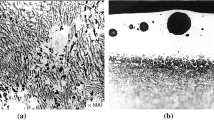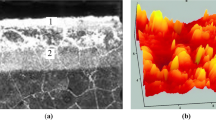The results of metal-physical studies of the specifics of structure formation of the chemical Ni–P coatings under pulsed laser irradiation and rapid crystallization of the surface layers of coated steels are presented. As a result, Ni3P type chemical compounds with a particle size of 0.05–0.25 μm and a given spatial orientation are formed on the surface of irradiated steels, which occupy 30–50% of the irradiated zone volume. This leads to an increase in hardness, wear resistance, and a decrease in the friction coefficients of the irradiated material surfaces. The problem of improving the properties, preventing cracking and grain growth in the “coating – steel substrate” composition is solved. In this case, by using certain modes of pulsed laser surface irradiation, it becomes possible to preserve the properties of the core metal. It is shown that an increase in adhesion between coatings and a metal substrate occurs due to the formation of a 2–3 μm thick transition layer. This is more than the thickness of the transition layer (0.16–0.2 μm) formed in the process of extended bulk heating of the coatings. According to the metal-physical studies, this ensures a smooth transition of properties from the coating to the steel substrate along with a decrease in the localization of stresses at the “coating – substrate” interface. The reason for this has to do with the diffusion processes during mixing of the coating with the surface layer of the steel substrate melted by laser irradiation. It has been established that the possible perturbation of the micro-geometry of the irradiated surface of the coatings should be corrected by choosing the coefficient of overlapping of the irradiation spots in the range of 0.7–0.8. Regression models for predicting the structure and properties of the irradiated “chemical coating – steel substrate” composition have been created, which allow obtaining the required mechanical, technological, and performance properties of the irradiated products with various functionalities by purposefully selecting the laser treatment process parameters. It was found that after the laser treatment of Ni–P coatings, the hardness of the surface layers reaches its maximum values at a radiation power density of 100 MW/m2 (steels U8A, P6M5, and P18) and 90 MW/ m2 (steel X12M), while the values of hardness and performance properties are 10–60% higher than those of the coatings without laser treatment.







Similar content being viewed by others
References
S. A. Vishenkov, Chemical and Electrochemical Methods of Depositing Metal Coatings [in Russian], Mashinostroyeniya, Moscow (1976).
A. V. Brover, V. N. Pustovoit, and G. I. Brover, “Structural organization and properties of the coating-metal base composition under pulsed laser exposure,” Uprochn. Tekhnol. Pokr., No. 3, 15–18 (2012).
L. I. Tushinskii, Study of the Structure, Physical and Mechanical Properties of the Coatings [in Russian], Mashinostroyeniya, Moscow (1986).
A. G. Grigoryanc, I. N. Shiganov, and A. I. Misyurov, Technological Processes of Laser Processing, Publishing house of MSTU im. Bauman, Moscow (2006).
V. S. Kraposhin, “Relationship between microstructure features and heat and mass transfer characteristics in iron of technical purity during laser heating,” Physics and Chemistry of Materials Processing, No. 1, 32–37 (1989).
A. A. Vedenov and G. G. Gladush, Physical Processes during Laser Treatment of Materials [in Russian], Enegroatomizdat, Moscow (1985).
G. V. Lomaev and Ye. V. Kharanzhevskii, Strengthening surface treatment by high-speed laser recrystallization,” Metalloved. Term. Obrab. Met., No. 3, 27–32 (2002).
P. K. Galenko, Ye. V. Kharanzhevskii, and D. A. Danilov, “High-speed crystallization of structural steel during laser surface treatment,” Zhurn. Tekhn. Fiz., 72, 5, 48–55 (2002).
B. S. Bokshteyn, Diffusion in Metals [in Russian], Metallurgiya, Moscow (1978).
B. Ya. Lyubov, Diffusion Processes in Heterogeneous Solid Media [in Russian], Nauka, Moscow (1981).
X. Li and Y. Guan, “Theoretical fundamentals of short pulse laser–metal interaction: A review,” Nanotechnology and Precision Engineering, No. 3, 105–125 (2020).
S. Roy, J. Zhao, P. Shrotriya, and S. Sundararajan, “Effect of laser treatment parameters on surface modification and tribological behavior of AISI 8620 steel,” Tribology International, 112, 94-102 (2017).
A. Gabdrakhmanov, A. Galiakbarov, and I. Gaisin, “Increasing efficiency of the laser action to materials,” Materials Today: Proceedings, 19, Part 5, 1965–1967 (2019).
S. Sihn, L. B. Childersac, C. T. Waltersad, M. S. Forte, A. K. Roy, and P. Vernon, “Computational and experimental study on laser heating of a Ni-based metal alloy,” Intern. J. Heat and Mass Transfer, 102, 1034–1043 (2016).
M. Katancik, S. Mirzababaei, M. Ghayoor, and S. Pasebani, “Selective laser melting and tempering of H13 tool steel for rapid tooling applications,” J. Alloys and Compounds, 849, Art. 156319 (2020); https://doi.org/10.1016/j.jallcom.2020.156319.
Q. Cai, C. Zhai, Q. Luo, T.-Y. Zhang, and Q. Li, “Effects of magnetic field on the microstructure and mechanical property of Mg–Al–Gd alloys,” Materials Characterization, 154, 233–240 (2019).
A. M. Sementsev, “Features of structure formation in low alloy steels during laser treatment,” Automation and modern technologies, No. 7, 16–18 (2006).
W. Xuan, L. Du, Y. Han, W. Shao, H. Zhang, J. Wang, Y. Zhong, and Z. Ren, “Investigation on microstructure and creep properties of nickel based single crystal superalloys PWA1483 during heat treatment under an alternating magnetic field,” Materials Science and Engineering: A, 762, Art. 138087 (2019).
A. Gunen, M. Kalkandelen, M. S. Gok, E. Kanca, B. Kurt, M. S. Karakas, I. H. Karahan, and M. Cetin, “Characteristics and high temperature wear behavior of chrome vanadium carbide composite coatings produced by thermo-reactive diffusion,” Surface & Coatings Technology, 402, Art. 126402 (2020).
A. V. Brover, G. I. Brover, and I. A. Topolskaya, “Wear resistance structural aspects of materials after laser processing,” IOP Conference, Ser. Materials Science and Engineering, 969, Art. 012008 (2020); https://doi.org/10.1088/1757-899X/969/1.
Author information
Authors and Affiliations
Corresponding author
Additional information
Translated from Metallurg, Vol. 66, No. 9, pp. 71–77, September, 2022. Russian DOIhttps://doi.org/10.52351/00260827_2022_09_71.
Rights and permissions
Springer Nature or its licensor (e.g. a society or other partner) holds exclusive rights to this article under a publishing agreement with the author(s) or other rightsholder(s); author self-archiving of the accepted manuscript version of this article is solely governed by the terms of such publishing agreement and applicable law.
About this article
Cite this article
Brover, G.I., Shcherbakova, E.E. Morphology and Properties of Chemical Coatings on Steels After Extreme Thermal Laser Radiation Effects. Metallurgist 66, 1105–1113 (2023). https://doi.org/10.1007/s11015-023-01423-5
Received:
Revised:
Accepted:
Published:
Issue Date:
DOI: https://doi.org/10.1007/s11015-023-01423-5




